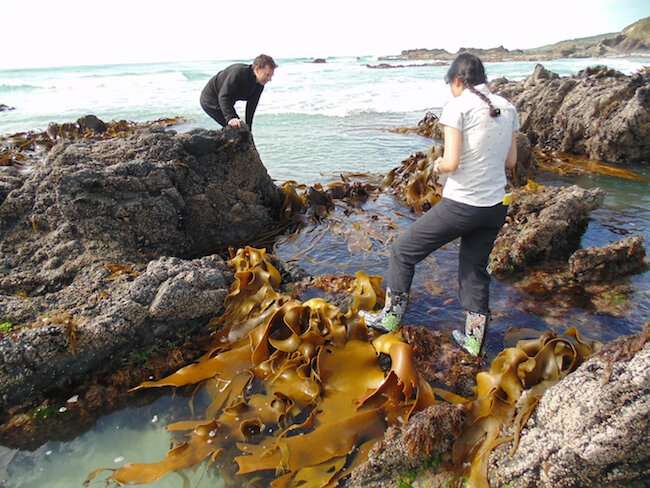Otago biologists (Professor Jon Waters and PhD student Elahe Parvizi) sampling kelp on the southern New Zealand coast that was uplifted by the Akatore earthquake around 1000 years ago. The uplifted rocky bench visible in the background represents the old shore. Credit: Dave Craw
One of the most memorable and astonishing aspects of the recent Kaikoura earthquake was the sudden uplift of the sea floor, which left populations of coastal species like kelp and shellfish literally high and dry.
That quake of November 2016 provided proof of the destructive power of sudden geological uplift. While such events are clearly devastating for coastal populations—at least in the short term—their potential longer-term implications are not so clear.
In a new Marsden-funded study, Otago University researchers have revealed an ancient genetic "footprint" of a similarly large earthquake that hit southern New Zealand some 1000 years ago, before humans had even reached the South Pacific nation.
This prehistoric rupture of the Akatore Fault—just south of Dunedin—uplifted a large-stretch of New Zealand's southeastern coast by 2–3 meters, and was likely a high magnitude event. The Akatore Fault remains a bigger threat to Dunedin than the Alpine Fault which runs through the length of the South Island's alpine zone.
The research team, led by geologist Professor Dave Craw, and biologist Professor Jon Waters, combined geological and genetic data to assess the impacts of the ancient quake.
"The old Akatore earthquake would have been similar in magnitude to the 2016 Kaikoura quake, with tens of kilometers of rocky coast affected, and the old shore lifted out of the water, well beyond the reach of the waves," says Professor Craw.
Zoology Ph.D. student, Miss Elahe Parvizi, used DNA evidence to compare modern samples of kelp along the uplifted Akatore coast, against populations from either side of the raised region.
"We were astonished to find a modern DNA footprint of the ancient quake—with a clear genetic difference between kelp in the uplifted zone, versus stable populations outside the uplift zone," Miss Parvizi says.
Similar to the recent Kaikoura earthquake, the ancient Akatore uplift was big enough to eliminate entire populations of intertidal species—which were subsequently replaced by genetically distinct lineages from outside the uplift zone. This DNA anomaly is still detectable today, and represents a modern trace of the ancient Akatore quake.
"These findings show that a major disturbance event—even an ancient one like the Akatore quake—can leave a lasting DNA signature. In the same way, major events happening now will leave a lasting legacy for the future," says Professor Waters.
The team now plans to use genetic approaches to shed new light on ancient earthquake disruption events elsewhere in NZ and overseas.
More information: Elahe Parvizi et al. Kelp DNA records late Holocene paleoseismic uplift of coastline, southeastern New Zealand, Earth and Planetary Science Letters (2019). DOI: 10.1016/j.epsl.2019.05.034
Journal information: Earth and Planetary Science Letters
Provided by University of Otago






















